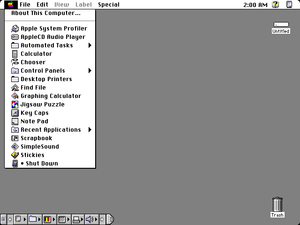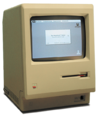This article has multiple issues. Please help improve it or discuss these issues on the talk page. (Learn how and when to remove these messages)
|
| Version of the classic Mac OS operating system | |
 Screenshot of Mac OS 7.6.1 | |
| Developer | Apple Computer |
|---|---|
| OS family | Macintosh |
| Working state | Historic |
| Source model | Closed source |
| Initial release | May 13, 1991 |
| Latest release | 7.6.1 / April 7, 1997 |
| Platforms | Motorola 68k series, PowerPC (since 7.1.2) |
| Kernel type | Monolithic (68k), nanokernel (PowerPC) |
| License | Proprietary |
| Preceded by | System 6 |
| Succeeded by | Mac OS 8 |
| Official website | Mac OS Releases at the Wayback Machine (archived April 12, 1997) |
| Tagline | It's powerful, it's easy to use-it's the new operating system for your Macintosh. |
| Support status | |
| Historical, unsupported as of May 2001 | |
| Part of a series on |
| Classic Mac OS |
|---|
 |
System 7 (later named Mac OS 7) is the seventh major release of the classic Mac OS operating system for Macintosh computers, made by Apple Computer. It was launched on May 13, 1991, to succeed System 6 with virtual memory, personal file sharing, QuickTime, TrueType fonts, the Force Quit dialog, and an improved user interface.[1][2]
It was code-named "Big Bang" in development and the initial release was named "The System" or "System" like all earlier versions. With version 7.5.1, the name "Mac OS" debuted on the boot screen, and the operating system was officially renamed to Mac OS in 1997 with version 7.6. The Mac OS 7 line was the longest-lasting major version of the Classic Mac OSes due to the troubled development of Copland, an operating system intended to be the successor to OS 7 before its cancellation and replacement with Mac OS 8.
- ^ Norton, Peter (1992). Inside System 7 (1st ed.). Brady Publishing. p. 215. ISBN 0-13-656273-6. Retrieved March 3, 2024.
- ^ Danuloff, Craig (April 6, 1991). The System 7 Book (4th ed.). Ventana Press, Inc. ISBN 0-940087-58-8. Retrieved March 3, 2024.